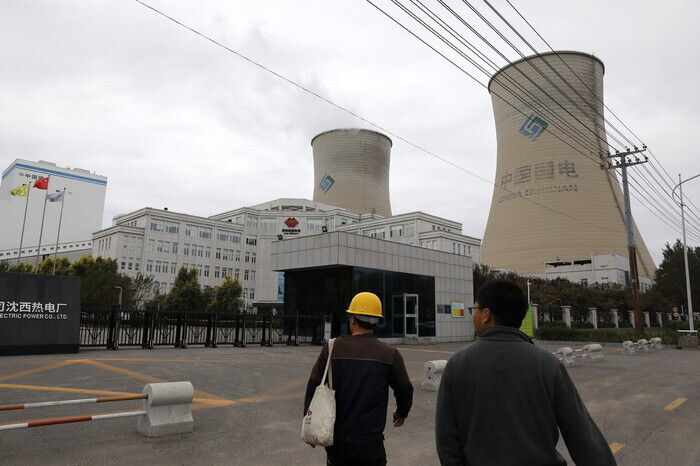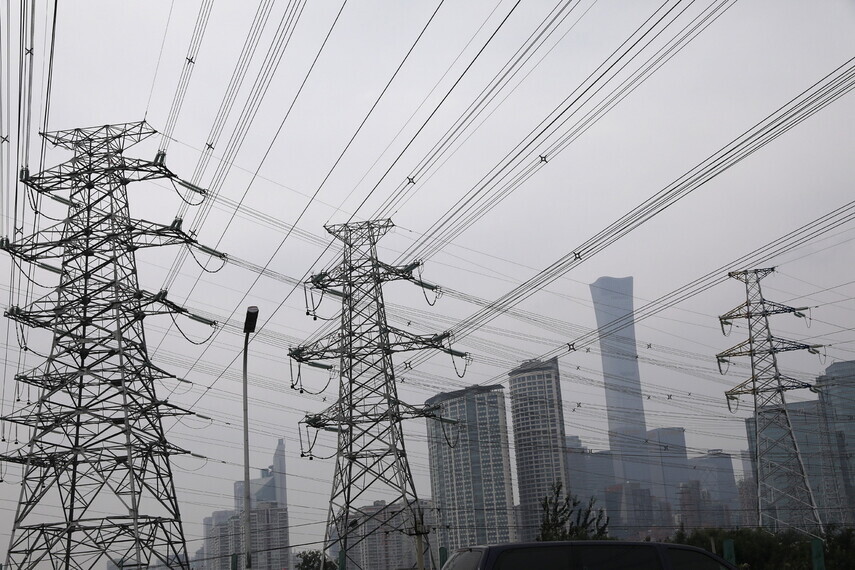hankyoreh
Links to other country sites 다른 나라 사이트 링크
[News analysis] Politics or structural problems? The story behind coal-dependent China’s power outages

The power crunch in China that began last month is lasting through the long holiday that began on National Day (Friday, Oct. 1) and continues through Thursday. Several explanations have been offered for the unusual power outages that have occurred in early fall, when demand for air conditioning has waned.
While China has seen power outages before, there’s little precedent for the current round of outages that have struck wide swathes of the country with no warning. According to reports in the Chinese press, power usage was restricted in 20 of China’s 31 provinces last month, including Guangdong, Zhejiang, Liaoning, and Jilin. A large number of factories have had to curtail or completely shut down operations.
The restrictions began at energy-intensive steel and aluminum refineries and have been extended to nearly all sectors, including textiles, food products, and electronics. Traffic lights in Shenyang, in Liaoning Province, went off in an outage, and there were numerous reports of people being stuck in elevators when the power went down.
Authorities in Shenzhen and Guangzhou, both in Guangdong Province, called off light shows that had been scheduled as part of National Day celebrations. Even Shanghai, the heart of the Chinese economy, announced that there would be blackouts “at certain times and in certain places” from Sept. 27 to Oct. 3.
Two main explanations have been offered for the power outages. According to the first explanation, the power crisis has been exacerbated by a shortage of coal, which accounts for 60.8% of all power generated in China. Demand for coal has surged around the world this year as COVID-19 restrictions have been eased, leading to an imbalance between supply and demand.
For countries that depend heavily on coal for power, like China and India (70.6%), a shortage of coal could make it hard to maintain energy output.
The second explanation is that regions of China that haven’t managed to reduce carbon emissions — a policy aggressively pursued by Chinese President Xi Jinping — have briefly stopped generating power. China’s “dual control” system, a policy of gradually reducing both total energy consumption and energy intensity, was adopted during the fifth plenary session of the 18th Central Committee of the Chinese Communist Party in October 2015, after Xi came to power.

According to the second explanation, local governments that failed to meet their yearly targets had to briefly halt energy production after receiving a warning from the central government in August.
These two explanations are contradictory — the first implies that China’s power outages were involuntary, while the second implies that they were voluntary. The Chinese government hasn’t offered a clear explanation of the outages. In the end, the media has been left to present a murky mixture of the two explanations.
That said, media that emphasize the special nature of the Chinese system emphasize that this is a “political incident” resulting from Xi’s policy of cutting carbon emissions, while media that focus on economic universals describe this as a “structural incident” resulting from a shortage of coal.
If the current outages are political in nature, they could be resolved before long. But if they’re structural, the situation could become protracted and have an impact on other countries.
Initially, the prevailing view was that the outages were due to China’s suspension of coal imports from Australia. But more recently, support has been growing for the argument that China’s energy policy has had a bigger impact. That has prompted predictions that the situation will unfold on a scale that’s tolerable to the Chinese government.
The Chinese media and energy experts observe that China often faces energy crunches, given a dependence on coal power so heavy it’s been described as an “addiction.”

According to the website Our World in Data, China produced around 30% of global energy last year (8,736 TWh, or terawatt-hours) — and 60.8% of that (4,631 TWh) came from coal.
Petroleum and natural gas only make up 2.1% (160 TWh) and 3.3% (253 TWh) of the energy mix, respectively, while hydropower, a renewable energy source, accounts for a surprisingly high share of 17.8% (1,355 TWh).
One reason for China’s heavy reliance on coal is the sheer amount of coal it produces. In 2019, China produced 3.8 billion tons of coal, representing 47% of the world’s coal output (8.1 billion tons). On top of that, China imported 230 million tons of coal. In short, China is consuming half of the world’s coal output.
Dependence on coal power means that power generation can be greatly affected by the supply of coal. During the recovery from the COVID-19 pandemic, demand for coal has risen, causing the price of 1 ton of coal to nearly triple this year, from US$80 in January to US$228 more recently.
Given the steep increase in coal prices, power stations have been forced to reduce output to stay profitable. Another factor appears to have been China’s suspension of imports of coal from Australia in September 2020 over a dispute between the two countries. China imported 45 million tons of coal from Australia in 2019.
In a speech before the 75th UN General Assembly in September 2020, Xi announced that China’s carbon emissions would peak in 2030 and that the country would achieve carbon neutrality by 2060.
Carbon neutrality means effectively achieving net zero in carbon emissions by using carbon sinks to offset the carbon dioxide that’s released into the air.
In short, Xi’s plan would wean China off its coal dependence over the next 40 years. While some critics point out that the plan is lacking in detail, others see it as a step forward when the leader of the country that consumes half the world’s coal makes an international pledge to achieve carbon neutrality. In a speech at the UN General Assembly on Sept. 21, Xi took things a step further and announced that China would no longer support the construction of coal plants overseas.
Cutting carbon emissions has become one of Xi’s chief policies along with “common prosperity.” While common prosperity, with its focus on distribution, is aimed at China, carbon neutrality, and the drive to emit less carbon dioxide, apply both to China and the world at large.
Since abolishing presidential term limits in March 2018, Xi has recently argued that the drive for carbon neutrality is one of the reasons he needs to stay in power. Xi’s dictatorial leadership appears to be driving a muscular policy of decarbonization.
By Choi Hyun-june, staff reporter
Please direct questions or comments to [english@hani.co.kr]

Editorial・opinion
![[Column] Park Geun-hye déjà vu in Yoon Suk-yeol [Column] Park Geun-hye déjà vu in Yoon Suk-yeol](https://flexible.img.hani.co.kr/flexible/normal/500/300/imgdb/original/2024/0424/651713945113788.jpg) [Column] Park Geun-hye déjà vu in Yoon Suk-yeol
[Column] Park Geun-hye déjà vu in Yoon Suk-yeol![[Editorial] New weight of N. Korea’s nuclear threats makes dialogue all the more urgent [Editorial] New weight of N. Korea’s nuclear threats makes dialogue all the more urgent](https://flexible.img.hani.co.kr/flexible/normal/500/300/imgdb/original/2024/0424/7317139454662664.jpg) [Editorial] New weight of N. Korea’s nuclear threats makes dialogue all the more urgent
[Editorial] New weight of N. Korea’s nuclear threats makes dialogue all the more urgent- [Guest essay] The real reason Korea’s new right wants to dub Rhee a founding father
- [Column] ‘Choson’: Is it time we start referring to N. Korea in its own terms?
- [Editorial] Japan’s rewriting of history with Korea has gone too far
- [Column] The president’s questionable capacity for dialogue
- [Column] Are chaebol firms just pizza pies for families to divvy up as they please?
- [Column] Has Korea, too, crossed the Rubicon on China?
- [Correspondent’s column] In Japan’s alliance with US, echoes of its past alliances with UK
- [Editorial] Does Yoon think the Korean public is wrong?
Most viewed articles
- 1‘We must say no’: Seoul defense chief on Korean, USFK involvement in hypothetical Taiwan crisis
- 2Will NewJeans end up collateral damage in internal feud at K-pop juggernaut Hybe?
- 3[Column] Park Geun-hye déjà vu in Yoon Suk-yeol
- 4Why Korea shouldn’t welcome Japan’s newly beefed up defense cooperation with US
- 5Thursday to mark start of resignations by senior doctors amid standoff with government
- 6N. Korean hackers breached 10 defense contractors in South for months, police say
- 7[Guest essay] The real reason Korea’s new right wants to dub Rhee a founding father
- 8[Column] ‘Choson’: Is it time we start referring to N. Korea in its own terms?
- 9Kim Jong-un expressed ‘satisfaction’ with nuclear counterstrike drill directed at South
- 10[Editorial] New weight of N. Korea’s nuclear threats makes dialogue all the more urgent